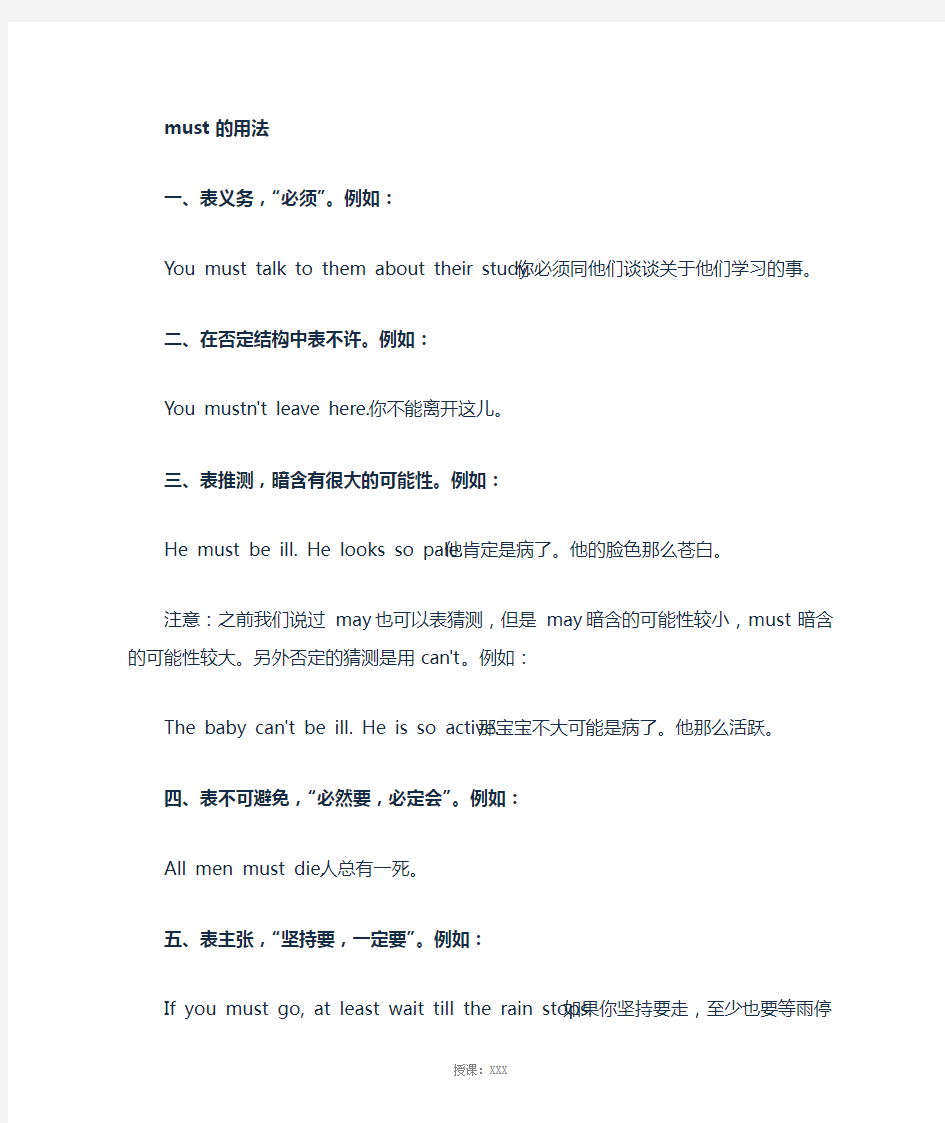

must 的用法
一、表义务,“必须”。例如:
You must talk to them about their study. 你必须同他们谈谈关于他们学习的事。
二、在否定结构中表不许。例如:
You mustn't leave here. 你不能离开这儿。
三、表推测,暗含有很大的可能性。例如:
He must be ill. He looks so pale. 他肯定是病了。他的脸色那么苍白。
注意:之前我们说过 may 也可以表猜测,但是 may 暗含的可能性较小,must 暗含的可能性较大。另外否定的猜测是用can't。例如:
The baby can't be ill. He is so active. 那宝宝不大可能是病了。他那么活跃。
四、表不可避免,“必然要,必定会”。例如:
All men must die. 人总有一死。
五、表主张,“坚持要,一定要”。例如:
If you must go, at least wait till the rain stops. 如果你坚持要走,至少也要等雨停了再走。
六、关于 must 的简短回答:
-Must I clean the dining room at once? 我必须马上打扫膳厅吗?
-Yes, you must. 是的。
-No, you needn't. / No, you don't have to. 不必马上打扫。
have to 的用法
一、have to 表客观的需要和义务,must 表主观的认识。例如:
I missed the train, so I had to take a taxi. 我没搭上火车,所以我只得打的。(客观上需要打的)
I must study hard. 我必须努力学习。(主观上认为应该努力学习)
二、在疑问句和否定句中,have to 多用助动词 do 构成,must 则直接提前或加not。例如:
Did he have to do it? = Must he do it? 他得做那件事吗?
而且在否定句中,have to 表不需要,must 表不允许:
You don't have to go there. 你不需要去那儿。
You mustn't go there? 你不可去那儿。
初一语法:连系动词及系表结构
连系动词也称系动词,它本身有词义,但不能单独用作谓语,后边必须跟表语共同构成复合谓语。
连系动词与其后的表语合起来叫作系表结构。系表结构说明主语的状况、性质、特征等情况。
一、状态系动词
用来表示主语状态,只有be一词。例如:
He is a teacher.他是一名教师。(is与表语一起说明主语的身份。)
二、持续系动词
用来表示主语继续或保持一种状况或态度,主要有keep,remain,stay,lie,stand。例如:
He always kept silent at meeting.他开会时总保持沉默。
This matter remains a mystery.此事仍是一个谜。
三、表像系动词
用来表示“看起来像”这一概念,主要有seem,appear,look。例如:He looks tired.他看起来很累。
He seems (to be) very sad.他看起来很伤心。
四、感官系动词
感官系动词主要有feel,smell,sound,taste。例如:
This kind of cloth feels soft.这种布手感很软。
This flower smells very sweet.这朵花闻起来很香。
五、变化系动词
这些系动词表示主语变成什么样,主要有become,grow,turn,fall,get,go,come,run。例如:
He became mad after that.自那之后他疯了。
She grew rich within a short time.她没多长时间就富了。
六、终止系动词
表示主语已终止动作,主要有prove,turn out,表达“证实”,“变成”之意。例如:
The rumor proved false. 这谣言证实有假。
The search proved difficult. 搜查证实很难。
His plan turned out a success. 他的计划终于成功了。(turn out表终止性结果)
语法:情态动词can与may的用法
2015-07-10 17:54:26 | 初一语法
情态动词
情态动词有一定的词义,但词义不完全,须同动词原形连用;
情态动词没有人称和数的变化;
疑问句直接把情态动词提前,否定句在情态动词后面加not。
*情态动词中有一类是具有情态动词特征的词,如have to,但它有人称、数的变化,它的疑问句和否定句的构成方式也和其他情态动词有所不同。
can 的用法
一、表能力,有“能,会,能够”的意思。例如:
-Can you drive a car? 你会开车吗?
-Yes, I can. 我会。/ No, I can't. 我不会。
二、表允许,在口语中代替may,有“可以”的意思。
(见下面 may 的用法第四点)
三、表示可能性,常用于否定句和疑问句。例如:
Can it be true? 那会是真的吗?
Today is Sunday. He can't be at school. 今天是星期天,他不可能在学
校里。
很多同学都不太清楚 can 与 be able to 的异同吧,赶快来学习一下吧>> may 的用法
一、表示许可或征求对方的许可,有“可以”的意思。例如:
You may go now. 你可以走了。
May I use your computer? 我用一下你的电脑可以吗?
二、回答以 may 开头的疑问句有如下表达法:
-May I smoke here? 我可以在这儿抽烟吗?
-Yes, you may. / Yes, please. 请抽吧。
-No, you can't. / No, you mustn't. / No, you'd better not. 请不要抽烟。
三、表示猜测,通常只用于陈述句。例如:
You may be right. 你可能是对的。
四、在口语中 can 可以代替 may 表示许可,但 can 较随便,may 更正式。例:
Can I use your bike, John? 约翰,我可以用一下你的自行车吗?
May I have a look at your license please, sir? 先生,我可以看一下你的执照吗?
初一语法:dare的两种用法
2015-07-10 19:13:17 | 初一语法
今天我们再来学习一个和need很相近的词:dare。
Dare, meaning have the courage to do something, can also be used in two ways:
Dare的意思是“有勇气做某事”,它也有两种用法:
dare 作实义动词
* as an ordinary verb followed by an infinitive with to, with s in the third person singularand with questions and negatives formed with do:
作为实义动词时,接带to的不定式,第三人称单数作主语时加s,疑问句和否定句用do来构成:
He never dares to criticise her for wasting money and she doesn't dare to interrupt him when he's working.
他从不敢批评她浪费钱,而她不敢打扰他工作。
dare 作情态动词
* as a modal auxiliary verb followed by an infinitive without to, with no third person singular s and with questions and negatives without do: 作为情态助动词时,接不带to的不定式,第三人称单数作主语时不加s,疑问句和否定句不需要用do来构成:
Dare she tell him what she thinks about him? She daren't say anything. He will only shout at her. "How dare you speak to me like that?" he will say.
她敢告诉他她对他的想法吗?她什么也不敢说。他只会对着她咆哮:“你怎敢那样对我说话?”他肯定会这么说。
比较
Differences in use are not as fixed or clear cut between doesn't dare to and daren't as they are between doesn't need to and needn't, except in expressions or collocationssuch as:
doesn't dare to与daren't在用法上的差别不像doesn't need to和needn't那么固定或清晰,除了在以下这些表达和搭配中:
* How dare you?
你怎么敢?
eg: How dare you walk away when I'm talking to you?
我在跟你说话的时候你怎么敢走开?
* I dare you to…
我谅你不敢……
I dare you to go up to him and ask him for a date.
我谅你也不敢走到他面前请他跟你约会。
* I dare say…
我敢说……
I dare say you're pretty hungry after all that cycling.
我敢说你骑了那么久后肯定饿死了。
In this last example, I dare say means I suppose.
最后一例中的I dare say的意思是I suppose,我料想。
情态动词用于肯定猜测
1. must用于肯定句,表示较有把握的推测,意为“准是,一定”。后面
接动词原形,表示对现在的推测。如:
-I've had no sleep for 48 hours. 我已经48小时没睡觉了。
-You must be very tired. 你一定很累了。
2. should用于肯定句中,语气次之,意为“很可能,应该”,指按常理
推测。如:
They left yesterday. They should be home by now. 他们昨天就离开了,现在该到家了。
3. can用在肯定句中,表示理论上的可能性。如:
Smoking can cause cancer. 吸烟有可能引起癌症。
4. may用在肯定句中,表示对现在把握不大的推测,意为“也许,可能”。如:
Don't play with the knife. You may cut yourself. 不要玩小刀,你可能
会伤了自己。
5. could, might也可表示推测意义,常用在过去时态中;但在某些场合下,为了使语气更缓和、更委婉,常用could, might代替can, may。如:They saw something in the sky last night. It could/might be a UFO.
昨天晚上他们看见天空中有个东西。它有可能是不明飞行物。
You may/might/could be very tired. 你可能很累吧!
情态动词用于否定猜测
1. 表示否定的推测时,can't/couldn't语气最强,指“不可能”,带有惊异、怀疑的感情色彩。如:
The story sounds reasonable, but it can't be true. 这个故事听起来合
情合理,但不可能是真的。
2. 语气不很肯定时,常用may not或might not表否定推测,意为“可能不,也许不”。如:
He may not/might not be at home. 他可能不在家。
情态动词用于疑问句表猜测
疑问句中的推测,常用can或could,意为“可能”。如:
Who can it be? Can it be Jenny? 那会是谁呢?是珍妮吗?
The money has disappeared! Who could have taken it? 钱不见了!会是谁拿去的呢?
Oh, how could you be so stupid? 哦,你怎么会这么愚蠢呢?
(注:可编辑下载,若有不当之处,请指正,谢谢!)